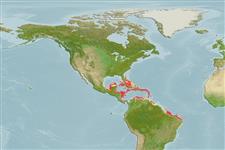>
Blenniiformes (Blennies) >
Chaenopsidae (Pike-, tube- and flagblennies)
Etymology: Lucayablennius: Composed from Lucaya = the old name for the Bahamas Islands + Greek, blennios = mucus (Ref. 45335).
Environment: milieu / climate zone / depth range / distribution range
पारिस्थितिकी
समुद्री प्रवाल-भित्ति संयुक्त; गहराई सीमा 13 - 106 m (Ref. 9710). Tropical
Western Central Atlantic: Bahamas and Caribbean, including the Antilles.
आकार / वज़न / Age
Maturity: Lm ? range ? - ? cm
Max length : 5.0 cm SL पुल्लिंग / अलिंग; (Ref. 51458)
Short description
आकृति विज्ञान | मौरफोमैटरिक्स
पृष्ठीय रीढ़ (सम्पूर्ण): 18 - 20; पृष्ठीय सौफट रेज़ (सम्पूर्ण): 19-20; गुदा कांटा 2; ऐनल सौफट रेज़: 22 - 23. With emarginate caudal fin. Reddish tan, with 3 large dark spots along rear of dorsal fin base, and 2 similar spots along rear of anal fin base (Ref. 26938). Black stripe from tip of lower jaw through eye to end of operculum; a median dorsal light yellow line on head (Ref. 13442).
Inhabits coral reefs (Ref. 5521). Drifts with bended tail to prey on small fish. Retreats into holes or empty worm tubes. Ignores divers (Ref. 9710). Often seen with schools of masked gobies (Ref. 26938).
Life cycle and mating behavior
परिपक्व अवधि | पुनरुत्पत्ति | मछलीऔ का अंडे देना | अंडे | Fecundity | लार्वा
Böhlke, J.E. and C.C.G. Chaplin, 1993. Fishes of the Bahamas and adjacent tropical waters. 2nd edition. University of Texas Press, Austin. (Ref. 5521)
IUCN Red List Status (Ref. 130435)
Threat to humans
Harmless
Human uses
अधिक जानकारी
आम नामउपशब्दचपायचयपरभक्षीईकोटोकसीकोलौजीपुनरुत्पत्तिपरिपक्व अवधिमछलीऔ का अंडे देनाSpawning aggregationFecundityअंडेEgg development
Age/Sizeबाढ़Length-weightLength-lengthLength-frequenciesमौरफोमैटरिक्सआकृति विज्ञानलार्वालारवल गतिकीभर्तीबहुतायतBRUVS
संदर्भजलीयकृषिजलीयकृषि रूपरेखाखींचआनुवंशिकीElectrophoresesहैरेटिबिलटीबीमारीप्रक्रमणNutrientsMass conversion
सहयोगीयोतस्वीरेStamps, Coins Misc.ध्वनिसिगुयटिरारफ्तारतैरने के प्रकारगिल क्षेत्रOtolithsदिमागदृष्टि
साधन
Special reports
Download XML
इंटरनेट स्रोत
Estimates based on models
Preferred temperature (Ref.
123201): 23.5 - 27.6, mean 26.5 °C (based on 71 cells).
Phylogenetic diversity index (Ref.
82804): PD
50 = 1.0000 [Uniqueness, from 0.5 = low to 2.0 = high].
Bayesian length-weight: a=0.00457 (0.00183 - 0.01143), b=3.08 (2.86 - 3.30), in cm total length, based on LWR estimates for this (Sub)family-body shape (Ref.
93245).
Trophic level (Ref.
69278): 3.5 ±0.5 se; based on size and trophs of closest relatives
Fishing Vulnerability (Ref.
59153): Low vulnerability (10 of 100).
Nutrients (Ref.
124155): Calcium = 173 [78, 327] mg/100g; Iron = 0.905 [0.511, 1.640] mg/100g; Protein = 17.8 [16.6, 19.0] %; Omega3 = 0.125 [0.063, 0.243] g/100g; Selenium = 25.9 [10.7, 60.8] μg/100g; VitaminA = 366 [112, 1,263] μg/100g; Zinc = 2.2 [1.4, 3.3] mg/100g (wet weight);
